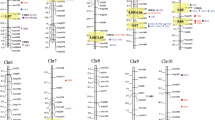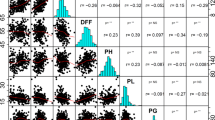Abstract
Development of micronutrient enriched staple foods is an important breeding goal in view of the extensive problem of ‘hidden hunger’ caused by micronutrient malnutrition. In the present study, kernel iron (Fe) and zinc (Zn) concentrations were evaluated in a set of 31 diverse maize inbred lines in three trials at two locations – Delhi (Kharif 2007 & 2008) and Hyderabad (Rabi 2007–08). The ranges of kernel Fe and Zn concentrations were 13.95–39.31 mg/kg and 21.85–40.91 mg/kg, respectively, across the three environments. Pooled analysis revealed significant genotype × environment (G × E) interaction in the expression of both the micronutrient traits, although kernel Fe was found to be more sensitive to G × E as compared to kernel Zn. Seven inbred lines, viz., BAJIM-06-03, DQPM-6, CM212, BAJIM-06-12, DQPM-7, DQPM-2 and CM129, were found to be the most stable and promising inbred lines for kernel Zn concentration, while for kernel Fe concentration, no promising and stable genotypes could be identified. Analysis of molecular diversity in 24 selected inbred lines with phenotypic contrast for the two kernel micronutrient traits, using 50 SSR markers covering the maize genome, revealed high levels of polymorphisms (214 SSR alleles; mean PIC value = 0.62). The phenotypically contrasting and genetically diverse maize inbred lines identified in this study could be potentially utilized in further studies on QTL analysis of kernel micronutrient traits in maize, and the stable and most promising kernel micronutrient-rich maize genotypes provide a good foundation for developing micronutrient-enriched maize varieties suitable for the Indian context.



Similar content being viewed by others
Abbreviations
- ANOVA:
-
Analysis of variance
- CIMMYT:
-
International maize and wheat improvement center
- PIC:
-
Polymorphism information content
- SSR:
-
Simple sequence repeat
- UPGMA:
-
Unweighted pair group method using arithmetic means
- QPM:
-
Quality protein maize
- QTL:
-
Quantitative trait loci
References
Arnold JM, Bauman LF, Aycock HS (1977) Interrelations among protein, lysine, oil, certain mineral element concentrations, and physical kernel characteristics in two maize populations. Crop Sci 17:421–425
Bantte K, Prasanna BM (2003) Simple sequence repeat polymorphism in Quality Protein maize (QPM) lines. Euphytica 129:337–344
Banziger M, Long J (2000) The potential of increasing the iron and Zn density of maize through plant breeding. Food Nutr Bull 21:397–400
Bouis H (2002) Plant breeding: a new tool for fighting micronutrient malnutrition. J Nutr 132:491S–494S
Chauhan RS (2006) Bioinformatics approach toward identification of candidate genes for zinc and iron transporters in maize. Curr Sci 91:510–515
Dixon MB, Kling JG, Menkir A, Dixon A (2000) Genetic variation in total carotene, iron and zinc contents of maize and cassava genotypes. Food Nutr Bull 21:419–422
Eberhart SA, Russell WA (1966) Stability parameters for comparing varieties. Crop Sci 6:36–40
Garg A, Prasanna BM, Chauhan SVS (2007) Simple sequence repeat (SSR) polymorphism in the tropical Asian maize inbred lines differing in resistance to banded leaf and sheath blight (Rhizoctonia solani f. sp. sasakii) in maize. Indian J Genet 67:238–242
Ghandilyan A, Vreugdenhil D, Aats MGM (2006) Progress in the genetic understanding of plant iron and zinc nutrition. Physiol Plant 126:407–417
Lodha ML, Prasanna BM, Pal RK (2005) Alleviating ‘hidden hunger’ through better harvest. Indian Farming 54(12):20–23
Menkir A (2008) Genetic variation for grain mineral content in tropical-adapted maize inbred lines. Food Chem 110:454–464
Mohammadi SA, Prasanna BM (2003) Analysis of genetic diversity in crop plants - salient statistical tools and considerations. Crop Sci 43:1235–1248
Nair SK, Prasanna BM, Garg A, Rathore RS, Setty TAS, Singh NN (2005) Identification and validation of QTLs conferring resistance to sorghum downy mildew (Peronosclerospora sorghi) and Rajasthan downy mildew (P. heteropogoni) in maize. Theor Appl Genet 110:1384–1392
Oikeh SO, Menkir A, Dixon BM, Welch RM, Glahn RP (2003a) Assessment of concentrations of iron and zinc and bioavailable iron in grains of early-maturing tropical maize varieties. J Agric Food Chem 51:3688–3694
Oikeh SO, Menkir A, Dixon BM, Welch RM, Glahn RP (2003b) Genotypic differences in concentration and bioavailabilty of kernel-iron in tropical maize varieties grown under field conditions. J Plant Nutr 26:2307–2309
Oikeh SO, Menkir A, Dixon BM, Welch RM, Glahn RP, Gauch G Jr (2004) Environmental stability of iron and zinc concentrations in grain of elite early-maturing tropical maize genotypes grown under field condition. J Agric Sci 142:543–551
Perrier X, Flori A, Bonnot F (2003) Data analysis methods. In: Hamon P et al (eds) Genetic diversity of cultivated tropical plants. Science Publishers, Montpellier, pp 43–76
Pfeiffer WH, McClafferty B (2007) HarvestPlus: breeding crops for better nutrition. Crop Sci 47(S3):S88–S105
Prasanna BM, Vasal SK, Kassahun B, Singh NN (2001) Quality protein maize. Curr Sci 81:1308–1319
Prasanna BM, Pixley K, Warburton ML, Xie CX (2010) Molecular marker-assisted breeding for maize improvement in Asia. Mol Breed 26:339–356
Saghai-Maroof MA, Soliman KM, Jorgenson R, Allard RW (1984) Ribosomal DNA space length polymorphisms in barley: Mendelian inheritance, chromosomal locations and population dynamics. Proc Natl Acad Sci 81:8014–8018
Sharma A, Chauhan RS (2008) Identification of candidate gene-based markers (SNPs and SSRs) in the zinc and iron transporter sequences of maize (Zea mays L.). Curr Sci 95(8):1051–1059
Singh D, Chonkar PK, Dwivedi BS (2005) Manual on soil, plant and water analysis. Westville Publishers, New Delhi
Smith JSC, Chin ECL, Shu H, Smith OS, Wall SJ, Senior ML, Mitchell SE, Kresovich S, Zigle J (1997) An evaluation of the utility of SSR loci as molecular markers in maize (Zea mays L.) : comparisons with data from RFLPs and pedigree. Theor Appl Genet 95:163–173
Solomons NW (2003) Zinc deficiency. In: Caballero B (ed) Encyclopedia of food sciences and nutrition, 2nd edn. Elsevier, England
Underwood BA (2000) Overcoming micronutrient deficiencies in developing countries: is there a role for agriculture? Food Nutr Bull 21:356–360
UNSCN (2004) 5th Report on the world nutrition situation. Nutrition for improved development outcomes. United Nations System Standing Committee on Nutrition, Geneva
Zarcinas BA, Cartwright B, Spouncer LR (1987) Nitric acid digestion and multi element analysis of plant material by inductively coupled plasma spectrometry. Comm Soil Sci Plant Anal 18:131–146
Acknowledgements
The study was carried out as a part of a Network Project on “Development of micronutrient enriched maize through molecular breeding” funded by the Department of Biotechnology (DBT), Govt. of India, and was undertaken in collaboration with CIMMYT-HarvestPlus team. The authors express their sincere thanks to Dr. Kevin Pixley (CIMMYT-HarvestPlus Maize Team Leader) for sharing the HarvestPlus maize lines for this study.
Author information
Authors and Affiliations
Corresponding author
Rights and permissions
About this article
Cite this article
Chakraborti, M., Prasanna, B.M., Hossain, F. et al. Identification of kernel iron- and zinc-rich maize inbreds and analysis of genetic diversity using microsatellite markers. J. Plant Biochem. Biotechnol. 20, 224–233 (2011). https://doi.org/10.1007/s13562-011-0050-9
Received:
Accepted:
Published:
Issue Date:
DOI: https://doi.org/10.1007/s13562-011-0050-9




